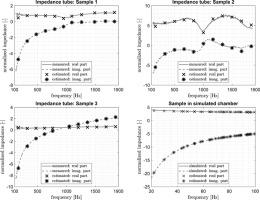Validation of an eigenvalue-based inverse method for estimating locally-reacting surface impedance
IF 3.4
2区 物理与天体物理
Q1 ACOUSTICS
引用次数: 0
Abstract
Accurate boundary condition descriptions are essential for creating accurate computational models for room acoustics. These descriptions are often defined in terms of absorption coefficients or surface impedances. However, obtaining complex-valued, frequency-dependent values for an acoustically absorbing material sample at low frequencies is a challenging task. In fact, the current measurement standard ISO 354:2003 does not provide a method for measuring absorption coefficients below 100 Hz. In this paper, a recently proposed eigenvalue-based inverse method for estimating locally-reacting impedance at measurement system resonance frequencies is validated. The validation uses data from three samples measured in an impedance tube. The method is also used to estimate complex-valued, frequency-dependent impedances at frequencies below 100 Hz in a measured reverberant room and in a simulated reverberation chamber.

基于特征值的反演法对局部反应表面阻抗估算的验证
准确的边界条件描述对于创建精确的室内声学计算模型至关重要。这些描述通常用吸声系数或表面阻抗来定义。然而,获取低频吸声材料样本的复值、频率相关值是一项极具挑战性的任务。事实上,目前的测量标准 ISO 354:2003 并没有提供测量 100 赫兹以下吸声系数的方法。本文验证了最近提出的一种基于特征值的逆方法,用于估算测量系统共振频率下的局部反应阻抗。验证使用了在阻抗管中测量的三个样品的数据。该方法还用于估算在测量混响室和模拟混响室中频率低于 100 Hz 的复值频率相关阻抗。
本文章由计算机程序翻译,如有差异,请以英文原文为准。
求助全文
约1分钟内获得全文
求助全文
来源期刊

Applied Acoustics
物理-声学
CiteScore
7.40
自引率
11.80%
发文量
618
审稿时长
7.5 months
期刊介绍:
Since its launch in 1968, Applied Acoustics has been publishing high quality research papers providing state-of-the-art coverage of research findings for engineers and scientists involved in applications of acoustics in the widest sense.
Applied Acoustics looks not only at recent developments in the understanding of acoustics but also at ways of exploiting that understanding. The Journal aims to encourage the exchange of practical experience through publication and in so doing creates a fund of technological information that can be used for solving related problems. The presentation of information in graphical or tabular form is especially encouraged. If a report of a mathematical development is a necessary part of a paper it is important to ensure that it is there only as an integral part of a practical solution to a problem and is supported by data. Applied Acoustics encourages the exchange of practical experience in the following ways: • Complete Papers • Short Technical Notes • Review Articles; and thereby provides a wealth of technological information that can be used to solve related problems.
Manuscripts that address all fields of applications of acoustics ranging from medicine and NDT to the environment and buildings are welcome.
 求助内容:
求助内容: 应助结果提醒方式:
应助结果提醒方式:


